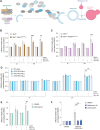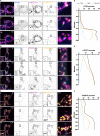Exposure of the inner mitochondrial membrane triggers apoptotic mitophagy
- PMID: 38396150
- PMCID: PMC10923902
- DOI: 10.1038/s41418-024-01260-2
Exposure of the inner mitochondrial membrane triggers apoptotic mitophagy
Abstract
During apoptosis mediated by the intrinsic pathway, BAX/BAK triggers mitochondrial permeabilization and the release of cytochrome-c, followed by a dramatic remodelling of the mitochondrial network that results in mitochondrial herniation and the subsequent release of pro-inflammatory mitochondrial components. Here, we show that mitochondrial herniation and subsequent exposure of the inner mitochondrial membrane (IMM) to the cytoplasm, initiates a unique form of mitophagy to deliver these damaged organelles to lysosomes. IMM-induced mitophagy occurs independently of canonical PINK1/Parkin signalling and is driven by ubiquitination of the IMM. Our data suggest IMM-induced mitophagy is an additional safety mechanism that cells can deploy to contain damaged mitochondria. It may have particular relevance in situations where caspase activation is incomplete or inhibited, and in contexts where PINK1/Parkin-mitophagy is impaired or overwhelmed.
© 2024. The Author(s).
Conflict of interest statement
ML is a member of the scientific advisory board and co-founder of Automera.
Figures






References
Publication types
MeSH terms
Substances
Grants and funding
LinkOut - more resources
Full Text Sources
Research Materials

